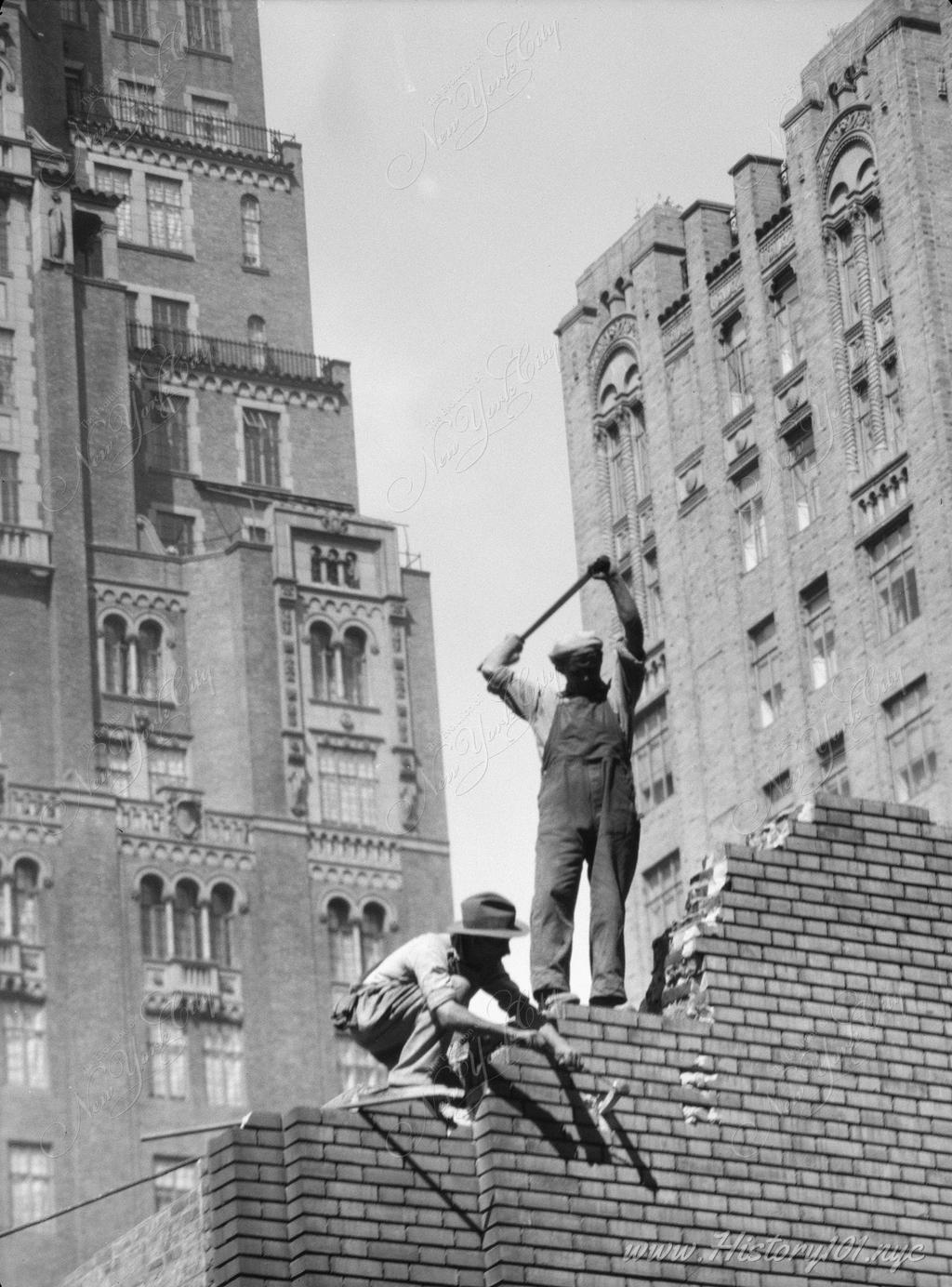
1925-1930 NYC: Art Deco Masterpieces, The Roaring Twenties, and Cultural Dynamism
In the period of 1925-1930, New York City experienced an unprecedented wave of cultural and architectural evolution, marking it as a pivotal epoch in urban history. This half-decade witnessed the completion of monumental architectural feats, most notably the Chrysler Building, which was finalized in 1930. Standing at 1,046 feet, it was the world’s tallest building at the time and became a symbol of the city’s architectural ambition and Art Deco style. Alongside, the development of the Empire State Building commenced in 1930, setting the stage for another landmark in the city’s skyline.
Culturally, the latter half of the Roaring Twenties in New York City was a vibrant period of artistic innovation and social change. The Harlem Renaissance continued to thrive, with artists, musicians, and writers like Duke Ellington and Langston Hughes pushing the boundaries of African American cultural expression. This era also saw the advent of the Broadway musical as a significant form of entertainment, attracting audiences from around the world and solidifying New York’s position as a global cultural capital.
Economically, the period up until the stock market crash of 1929 was marked by prosperity. Wall Street was the epicenter of financial activity, reinforcing New York City’s status as an economic powerhouse. The subsequent Great Depression, however, cast a shadow over the city, leading to economic challenges that affected every facet of urban life.
The late 1920s were also transformative in terms of technological advancements and media. Radio broadcasting became a significant aspect of daily life, with New York City stations like WEAF becoming household names. The city was at the forefront of the film industry too, before the shift to Hollywood, hosting premieres and contributing to the evolving cinema culture.
Socially, New York City in this era was a melting pot of diverse communities, each contributing to the city’s dynamic cultural landscape. However, this diversity also brought challenges in housing, employment, and social integration, especially as the effects of the Great Depression began to take hold.
Timeline of New York City’s History 1925-1930
Discover surprising historical facts about The City That Never Sleeps—explore fun, educational insights into its history, population, iconic landmarks, and more, perfect for students, history enthusiasts, and anyone curious about NYC’s rich heritage.
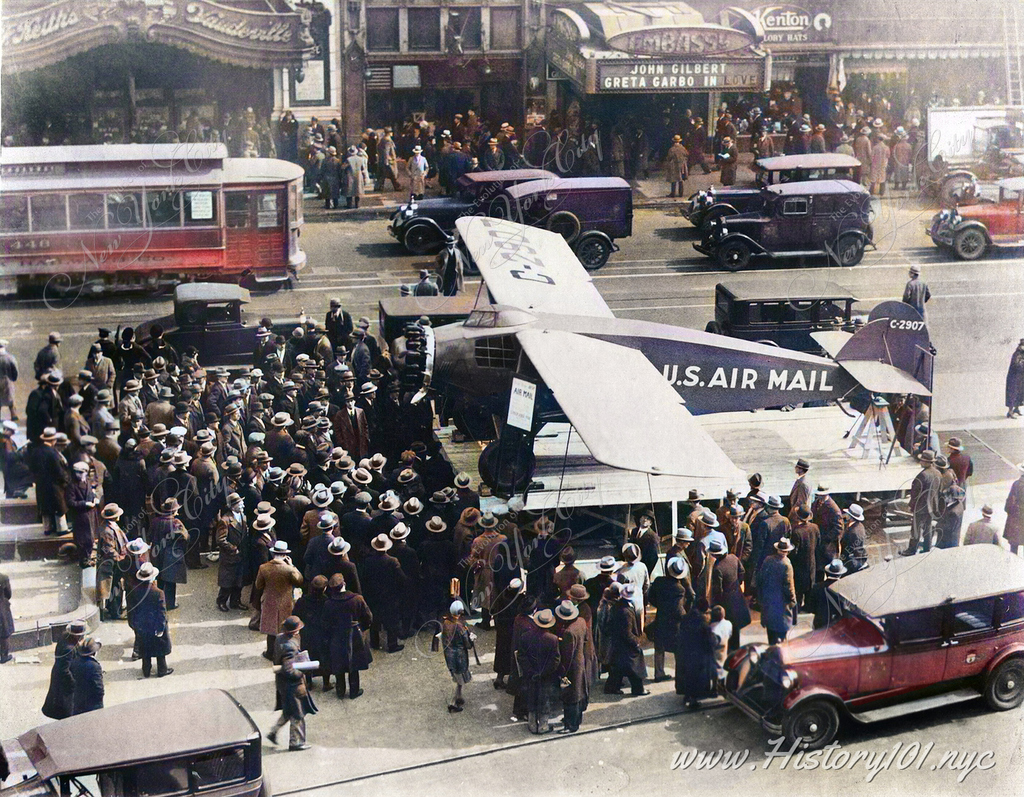
1927: Times Square Air Mail Exhibit: NYC's Pivotal Role in Aviation History
Explore the 1927 Times Square Air Mail plane display, a key moment in NYC's history, highlighting advancements in aviation and mail service
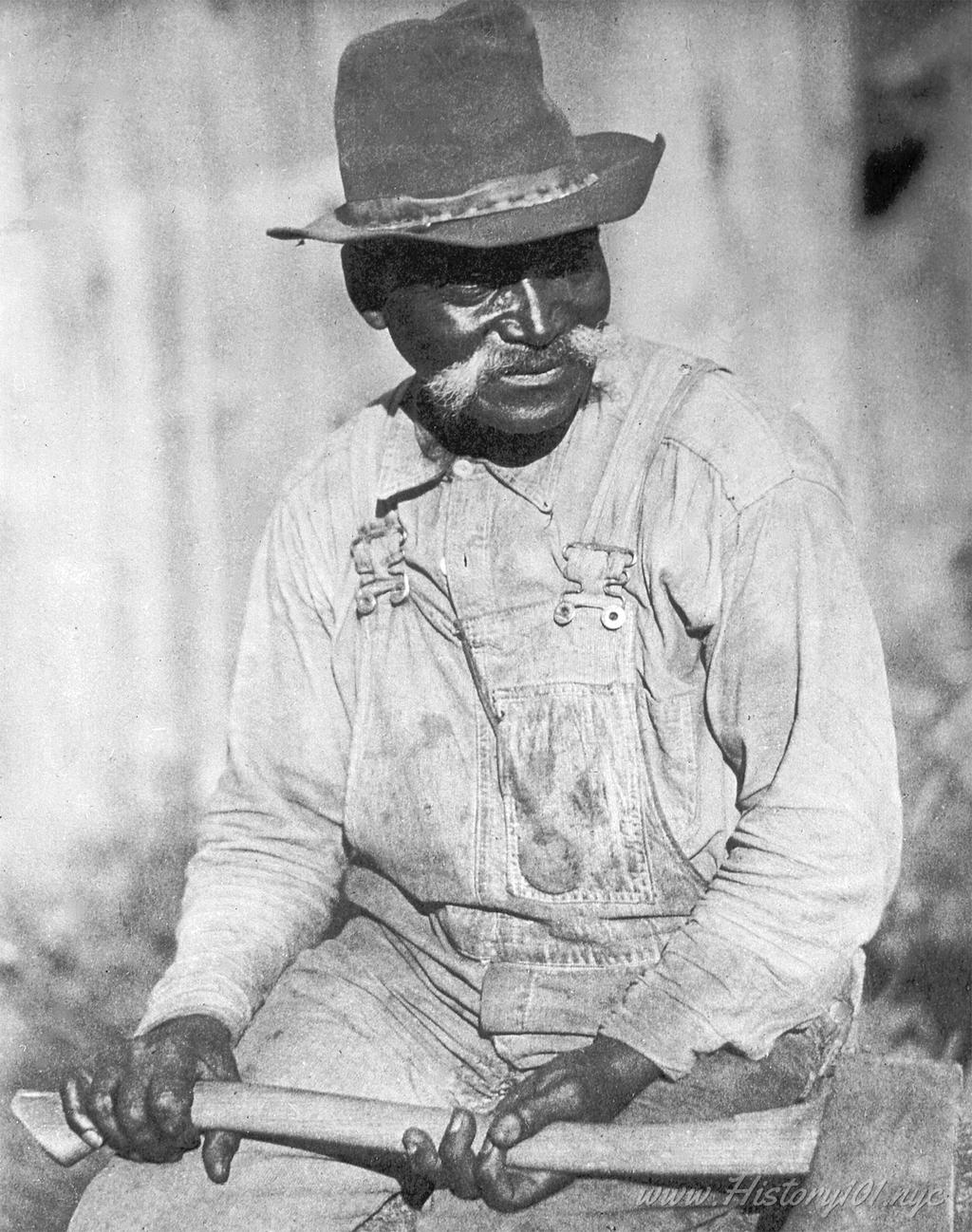
1925: New York City Laborer
Photograph of a New York City Laborer posing for a portrait with an axe in his hands.
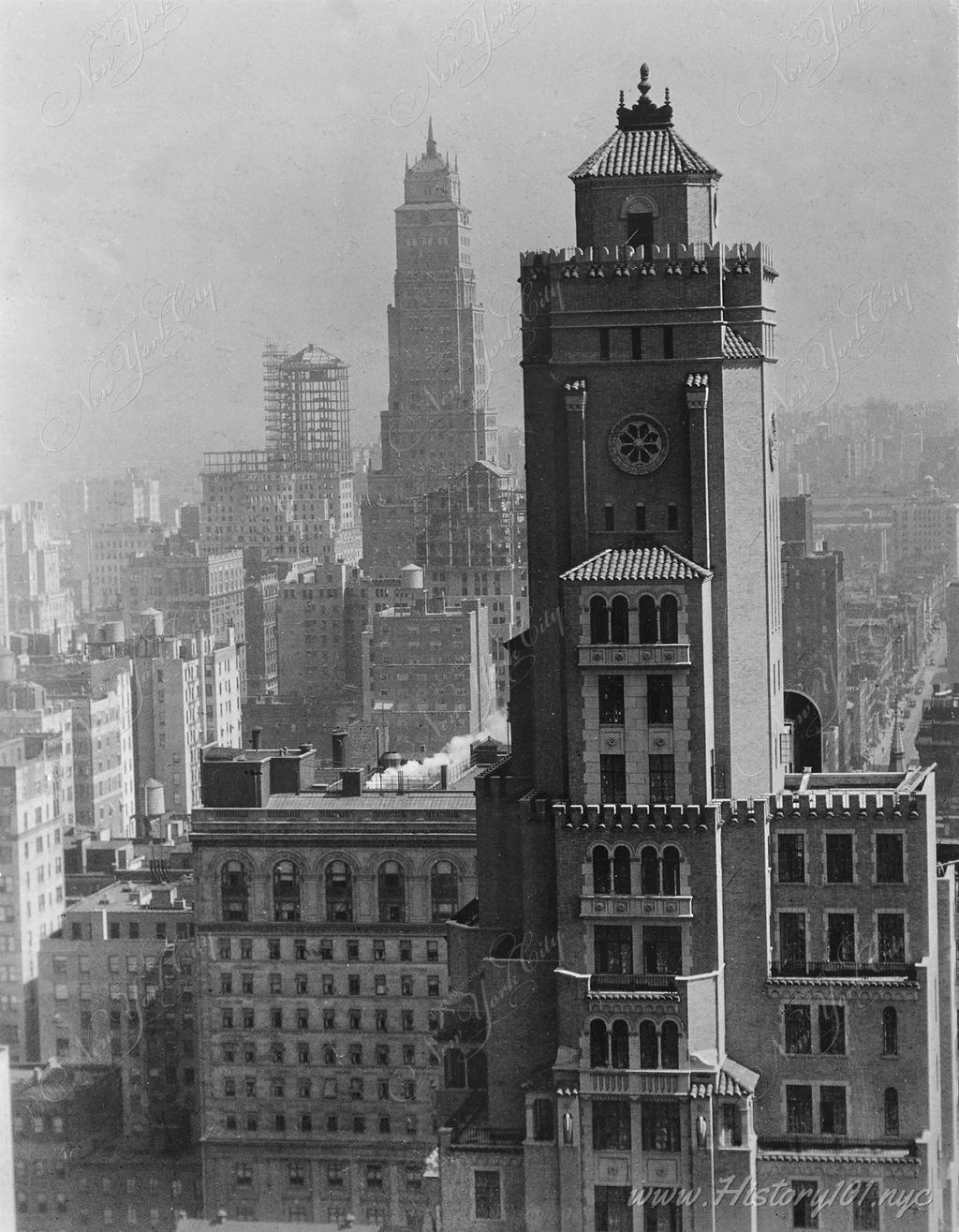
1927: 49th and Lexington - The Shelton Looking North
Photograph taken from The Shelton Hotel (James T. Lee) of the The Ritz Tower & Hotel Beverly (Emery Roth)

1925: Fifth Avenue in NYC: Lord & Taylor to Wendel Home – A Historic Snapshot
Explore a 1925 photograph of Fifth Avenue, capturing NYC's essence from Lord & Taylor to the Wendel home, reflecting urban growth and wealth
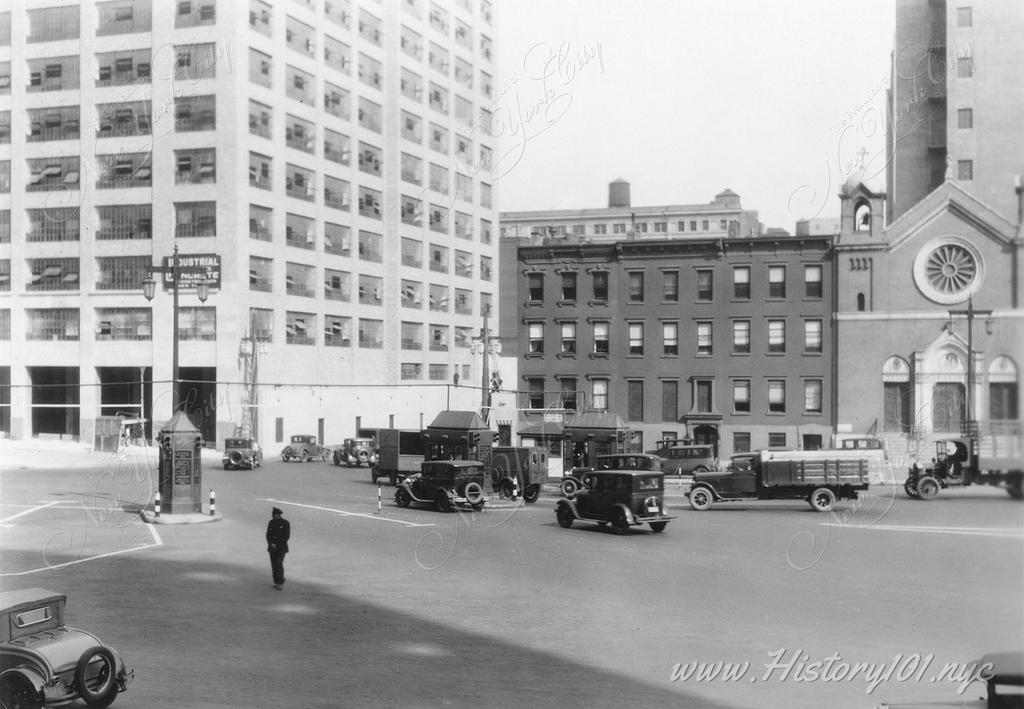
1929: Entrance To Holland Tunnel
New York City Entrance Plaza To Holland Tunnel which was opened by November 13, 1927.
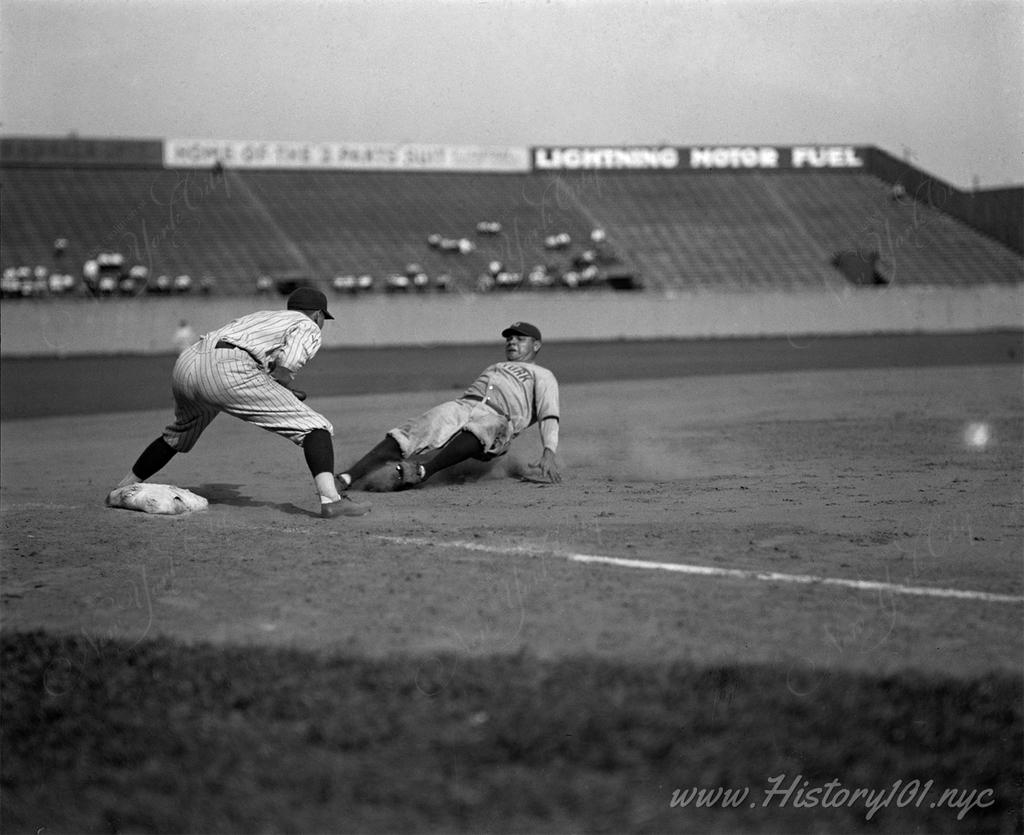
1925: Babe Ruth Sliding Into Third Base
Photograph of Babe Ruth out in fifth inning trying to go from first to third on Lou Gehrig's single, facing off against Senators third baseman Ossie Bluege.
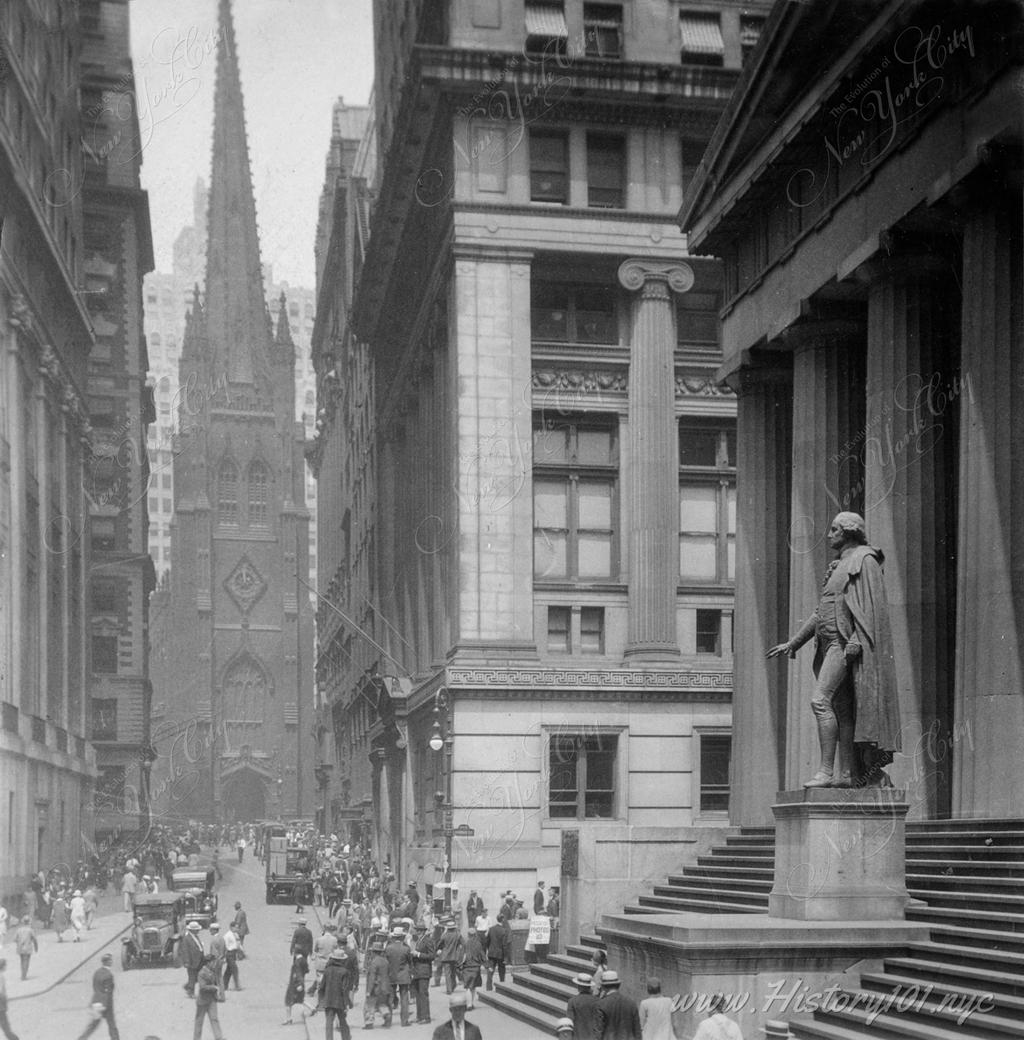
1928: Wall Street and Trinity Church
Photograph of pedestrians on Wall Street with Trinity Church in the background.

1927: Barclay and Vesey Streets
A photograph showing the New York Telephone Company Building, Barclay and Vesey Streets.
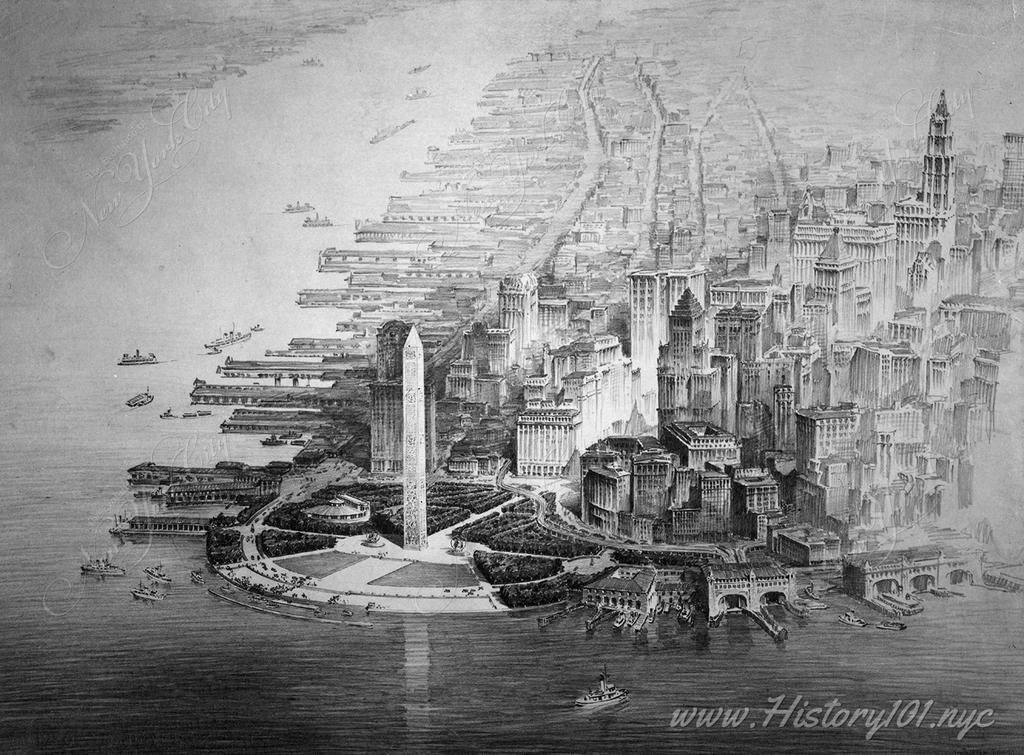
1929: Battery Park Proposal by Eric Gugler
An illustration of a potential design of Battery Park by Eric Gugler. The proposed design featured an obelisk structure and waterfront park.
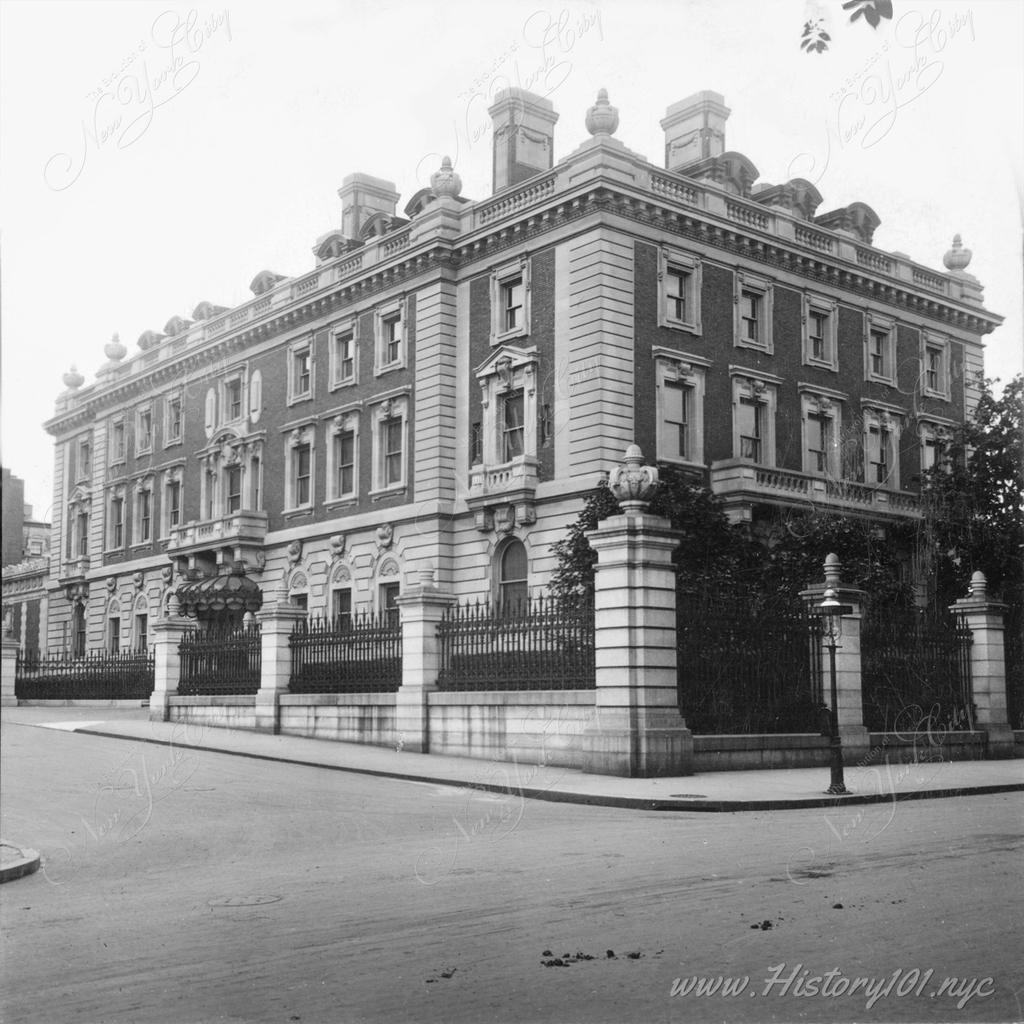
1926: Residence of Andrew Carnegie
Photograph of the home of Andrew Carnegie - an American industrialist who amassed a fortune in the steel industry then became a major philanthropist.
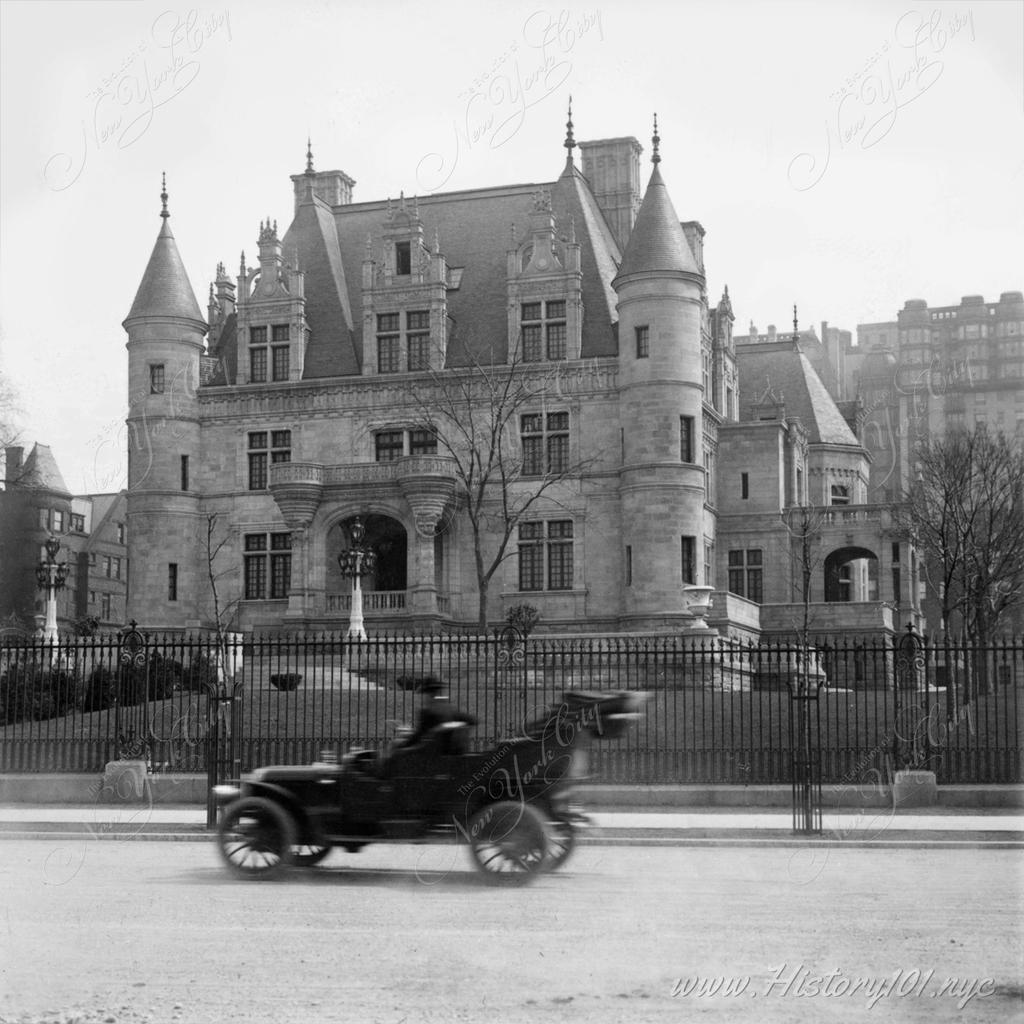
1926: Residence of Charles Schwab on Riverside Drive
Photograph of an automobile passing in front of the residence of Charles Schwab on Riverside Drive,
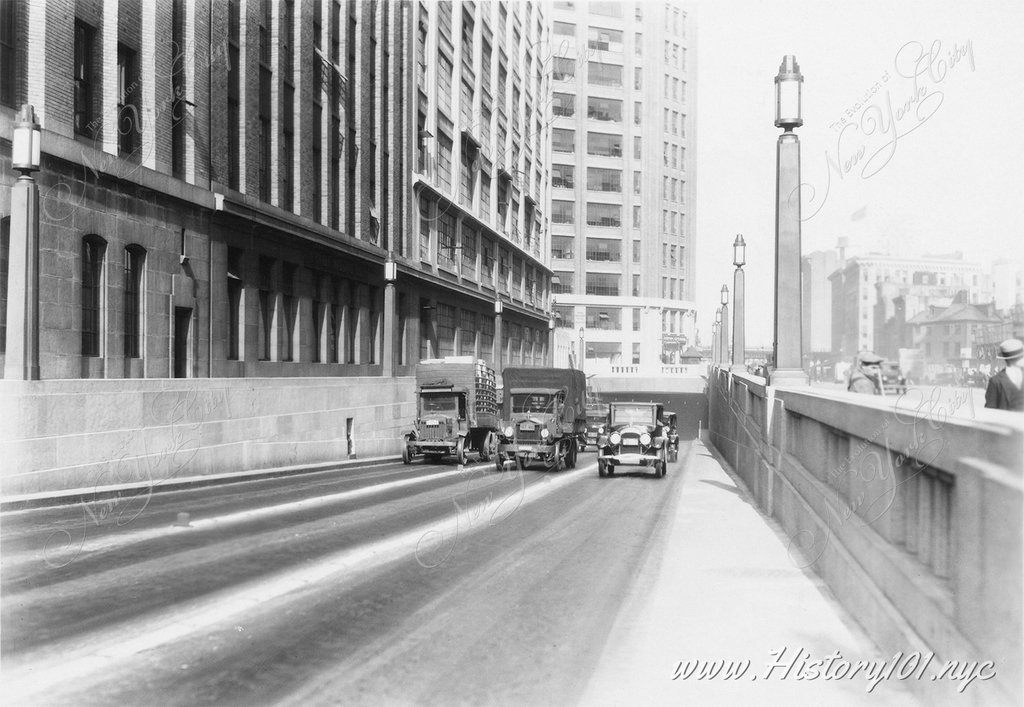
1929: Exit of Holland Tunnel on New York Side
New York outlet of the Holland Tunnel on U. S. Route 1. At the time of its completion in1920 it was the longest underwater tunnel for vehicular traffic in the world.
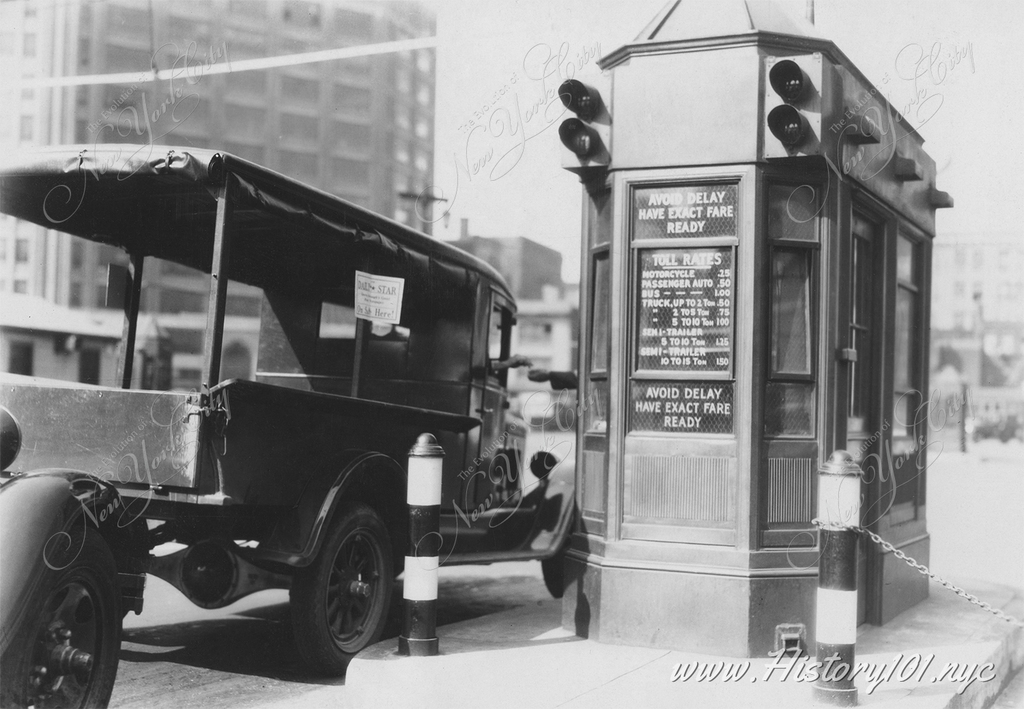
1929: Holland Tunnel Toll Booth
Toll booth in operation at entrance to Holland Tunnel in New York City on U. S. Route 1
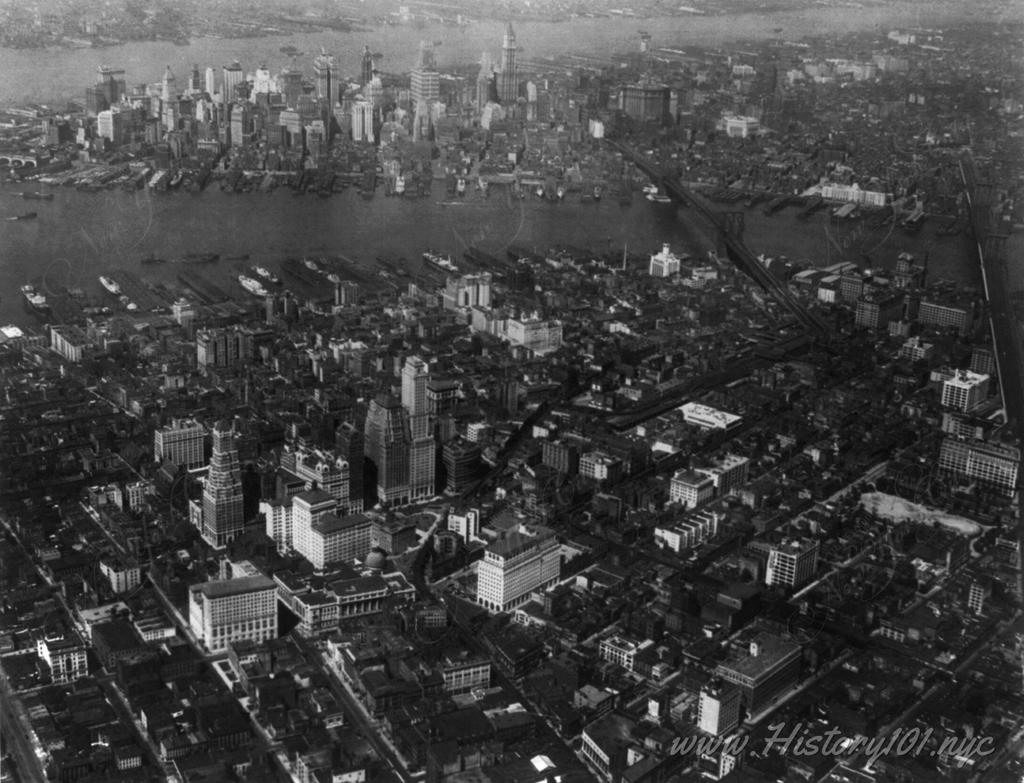
1927: Aerial View of Brooklyn and Manhattan
A bird's eye perspective of Brooklyn and Downtown Manhattan and both East River Bridges.
Timeline of New York City: 1925-1930
1925: Halfway between the decennial U.S. censuses, the estimated population of New York City was approximately 6,275,248. This estimation derives from calculating the midpoint between the 1920 census count of 5,620,048 and the 1930 census count of 6,930,446, reflecting a decade of steady growth. The city's growth was characterized by significant demographic shifts and urban development during this period, contributing to its status as a burgeoning metropolis. Each borough also experienced noticeable population increases, with developments in residential housing and infrastructure to accommodate the growing numbers.
Breaking down the estimates by borough, the Bronx saw its population increase to approximately 998,637, while Brooklyn's population grew to around 2,289,528. Manhattan, experiencing a slight decrease over the decade, had an estimated population of about 2,075,708. Meanwhile, Queens and Staten Island, the city's more suburban boroughs at the time, grew to populations of 774,084 and 137,448, respectively. These estimates are based on linear growth calculations from the 1920 and 1930 U.S. census data, offering a snapshot of New York City's dynamic demographic changes during the Roaring Twenties.
1925: Tannen's Magic Shop, established by Louis Tannen, is recognized as the oldest operating magic shop in New York City. The shop has long been a cornerstone of the local retail landscape, providing magicians with a trusted source for quality magic products and professional services. Over the decades, Tannen's Magic Shop has grown to earn international respect within the magic community, bolstering its reputation as a premier provider of magic supplies. This establishment not only serves working professionals in the field of magic but also enthusiasts and collectors, maintaining its status as a vital part of New York City’s vibrant cultural and entertainment scene.
In addition to retail services, Tannen's Magic Shop actively contributes to the magic community through various educational and promotional activities. Since 1974, the shop has sponsored Tannen's Magic Camp, a summer camp that offers young magicians a platform to learn and develop their craft. This camp has become a cherished annual event, fostering new generations of talent in the magical arts. Furthermore, Tannen's organizes the Tannen's Magic Shop Jubilee convention, an event highlighted by the presentation of the LOUIE award, which celebrates outstanding contributions to the field of magic. Tannen's Magic School, another initiative based in New York City, continues to educate and inspire magicians, underscoring the shop’s commitment to promoting the art of magic.
1925: WMCA began regular broadcasts on February 1, as New York City's 13th radio station, operating at a wavelength of 428.6 meters (700 kHz) with a transmission power of 500 watts. The station was initially located at the Hotel McAlpin in Herald Square, a location which inspired its call sign. Founded by Donald Flamm, WMCA was a pioneering station in the early days of radio. By 1928, WMCA had shifted its frequency to 570 kHz, sharing airtime with the municipally-owned WNYC for three years. On April 19, 1932, the Federal Radio Commission granted WMCA the approval to operate full-time on the 570 kHz frequency.
In December 1940, Donald Flamm was compelled to transfer ownership of WMCA to Edward J. Noble, a former Undersecretary of Commerce, following a deal entangled with notable political figures, including Thomas Corcoran. This change in ownership led to a protracted legal battle and a congressional investigation, ultimately concluding with a financial settlement for Flamm, although he did not regain control of the station. Throughout its early decades, WMCA diversified its offerings, including music, drama, and sports broadcasting such as New York Giants baseball games. In 1943, the station came under the ownership of the Straus family after Noble acquired the Blue Network (later ABC) from NBC. This period marked significant shifts in WMCA's programming and management, reflecting the dynamic nature of early broadcast media.
1925: On May 25 (Memorial Day), a significant technological advancement took place at the Rivoli Theater in Times Square, New York City, when Willis Carrier's centrifugal chilling system was installed. This event marked the first time a movie theater was equipped with modern air conditioning, fundamentally changing the movie-going experience. Carrier's innovative system was a "refrigerating plant" that utilized a new, more reliable, and less costly approach to cooling large spaces compared to previous methods. Although still large and expensive by contemporary standards, the system's success at the Rivoli Theater demonstrated its potential, paving the way for wider acceptance and use.
The installation of air conditioning in the Rivoli Theater not only provided relief from the summer heat but also transformed the theater into a haven for patrons during the warmer months. This led to a surge in movie attendance during summer, historically a slow season for theaters, and helped make it Hollywood's most profitable time of the year. The presence of air conditioning was so well received that Paramount Pictures founder Adolph Zukor was quoted as saying, "the people are going to like it." Indeed, this installation not only boosted the Rivoli Theater's popularity but also set a precedent for other theaters, contributing to the lasting trend of air-conditioned entertainment venues. Carrier’s system is now credited with fostering the summer blockbuster season, a staple of the film industry.
1926: The New York Life Building, a prominent fixture in the New York City skyline, began construction and was completed in 1928. Designed by celebrated architect Cass Gilbert, known for the Woolworth Building in lower Manhattan, this 34-story, 617-foot tall neo-Gothic office tower showcases a significant use of materials and architectural mastery. Its façade features 440,000 cubic feet of Indiana limestone, marking it as the largest single-building exterior stone order in the United States by 1928. Gilbert's design incorporates solid bronze for the framing of the building’s 2,180 windows and extends this material to numerous interior decorations and the building's large, ornate doors.
The New York Life Building is notably distinguished by its pyramidal roof, originally plated in gold leaf, which over time was replaced with gold-colored tile due to erosion. Historian Miriam Berman notes that the roof effectively captures and reflects sunlight, making it a distinct feature against the city’s illuminated skyline both day and night. Situated above Madison Square Park, the building not only contributes to the area's historic architecture but has also served as the headquarters for the New York Life Insurance Company since its completion. The company has played a crucial role in the revitalization of the neighborhood, consistently supporting the Madison Square Park Conservancy since its inception.
1926: The Savoy Ballroom, a monumental venue in the history of American social and cultural dynamics, opened its doors on March 12, in Harlem, New York City. Located between 140th and 141st Streets on Lenox Avenue, the Savoy was founded by Jewish businessman Moe Gale and white entrepreneur Jay Faggen, with African-American businessman and civic leader Charles Buchanan as its manager. The ballroom quickly became known as a symbol of the Harlem Renaissance, facilitating the fusion of Black and white cultures. It was also one of the first racially integrated public places in the United States. The venue was vast, with a capacity to accommodate around 5,000 patrons at a time, featuring two bandstands that supported continuous live music, which was crucial for hosting the famous dance contests and "battles of the bands."
Significantly, the Savoy Ballroom was dubbed the "Home of Happy Feet" and recognized as the birthplace of the Lindy Hop, a dance that became a cultural phenomenon. It showcased legendary dancers such as Leon James, Leroy Jones, Shirley “Snowball” Jordan, and George “Shorty” Snowden, who contributed to the vibrant atmosphere that the Savoy was celebrated for. The ballroom maintained its iconic status until it closed on July 10, 1958, leaving behind a legacy of groundbreaking social integration and musical innovation. Throughout its existence, the Savoy not only provided a platform for significant musical and dance developments but also stood as a pivotal gathering spot during an era of profound cultural shifts.
1926: On November 15, the National Broadcasting Company (NBC) made its debut, marking a significant milestone in broadcasting history. This event, held at the Waldorf Astoria Hotel in New York City, signified the launch of the first permanent radio network in the United States. NBC's inaugural broadcast was a lavish four-hour gala that showcased an array of talent from theater, concert, and radio. The event featured performances by notable figures such as opera singer Mary Garden, humorist Will Rogers, and singer Carl Schlegel. This broadcast was not just confined to New York but was also coordinated through WEAF and reached audiences across 22 stations spanning the East and Midwest, incorporating a remote link from KYW in Chicago.
NBC's early branding featured a logo that included a microphone encircled by lightning bolts, set against a backdrop of a map of the United States, with the "NBC" letters arched above the graphic. From its inception, NBC structured its operations into two main radio networks known as "red" and "blue." The "red" network primarily focused on entertainment and music, while the "blue" network was dedicated to delivering news content. This organizational setup allowed NBC to cater to diverse audience preferences and helped establish it as a formidable force in the broadcasting industry, laying the groundwork for its long-standing influence on American media.
1926: The Paramount Theatre in New York City opened its doors on November 19, with a grand premiere of Herbert Brenon's film "God Gave Me Twenty Cents." The opening gala was attended by luminaries such as Mayor Jimmy Walker, inventor Thomas Edison, film industry mogul Will H. Hays, and Broadway impresario Florenz Ziegfeld Jr. Situated at 43rd Street and Broadway, the theater was not only a cinematic venue but also served as the New York headquarters for Paramount Pictures. Its stage gala on opening night was produced by John Murray Anderson, setting a precedent for the theater's commitment to high-quality entertainment. The Paramount housed a Wurlitzer theater organ, one of the largest and most admired of its kind, designed for famous organist Jesse Crawford, who performed there from 1926 until 1933.
Throughout its operational years, the Paramount Theatre became a cultural landmark, known for hosting a blend of film screenings and live performances. By the swing era in the mid-1930s, it had become a prime venue for live music, featuring performances from major bands and artists including Benny Goodman, Tommy Dorsey, and Glenn Miller. The theater continued to be a key player in the music and film industry until it was closed under United Paramount Theatre ownership on August 4, 1964. It briefly reopened later that year on September 4, owned by Webb and Knapp. However, the theater was eventually gutted and transformed into retail and office space for The New York Times. The original Wurlitzer organ was removed and later installed in the Century II Convention Hall in Wichita, Kansas, in 1968, where it continues to be used for concerts and events today.
1926: Martha Graham established her own dance company and school, operating from a small studio located in Carnegie Hall, midtown Manhattan. This marked the beginning of her profound impact on the dance world through the development of her unique technique based on the elemental movements of contraction and release. This technique became the foundation for her emotionally charged dance vocabulary, designed to enhance the expressive capacity of the dancer's body. Throughout her career, Graham’s innovative approach to dance dramatically transformed the field, influencing countless artists and reshaping modern dance with movements that were sharp, angular, jagged, and direct.
Martha Graham's contributions to dance and choreography garnered her extensive recognition and numerous honors. Notably, she received the United States’ highest civilian honor, the Presidential Medal of Freedom, from President Gerald R. Ford in 1976, acknowledging her as a "national treasure." This made her the first dancer and choreographer to be bestowed with this prestigious award. Later, in 1985, President Ronald Reagan honored her as one of the inaugural recipients of the United States National Medal of Arts. Graham's legacy continues to inspire generations of performers across dance and theatre, embodying a pioneering American spirit that forever altered the landscape of performance arts.
1926: During Jimmy Walker's mayoral tenure, New York City experienced a vibrant cultural and infrastructural transformation. Walker, known for his charismatic and flamboyant lifestyle, led the city through the Roaring Twenties, a time when New York solidified its reputation for urban sophistication. Under his leadership, the city undertook significant projects such as the construction of the Triborough Bridge and the Midtown Tunnel, enhancing its infrastructure and fueling urban expansion. This period was also marked by grand ticker-tape parades at City Hall Plaza, celebrating figures like Charles Lindbergh and Gertrude Ederle, which brought the city together in communal celebration.
However, the latter part of Walker's administration was overshadowed by economic difficulties and allegations of corruption, which eventually led to his resignation in 1932. Despite these challenges, his era was characterized by a proactive approach to urban planning and development. Mayor Walker’s initiatives in expanding the subway system and other public works projects during his tenure from 1926 to 1932 reflect a dynamic period in New York City's history, where rapid changes and developments were juxtaposed with significant political and economic upheavals. This complex legacy highlights both the achievements and controversies of his time in office, illustrating the dual nature of his impact on the city's trajectory.
1926: On November 15, a pivotal moment in the history of American broadcasting occurred when AT&T sold its flagship radio station WEAF to the Radio Corporation of America (RCA) for $1 million. This transaction led to the creation of the National Broadcasting Company (NBC), marking the debut of the first major broadcast network in the United States. RCA, alongside partners General Electric and Westinghouse Electric, established NBC, which launched its first broadcast on the same day of the sale. The new network initially operated two divisions: the NBC Red Network, which focused on commercial entertainment and music programs to attract advertisers, and the NBC Blue Network, which was oriented towards cultural, educational, and public affairs programming.
The formation of NBC was a strategic move by RCA to use AT&T's vast network of telephone lines to enhance audio quality and distribution capabilities, laying the groundwork for national radio broadcasting. This setup allowed NBC to deliver high-quality broadcasts across its Red and Blue networks for the next fifteen years. The network structure and its operation as a dual-network system played a critical role in setting standards for future broadcast networks in the U.S., influencing the development of the industry. Over time, this led to the emergence of other networks such as CBS in 1927 and Mutual Broadcasting System in 1934, further shaping the American media landscape. NBC's significant impact was recognized in 1941 when the Federal Communications Commission identified it as a monopoly, leading to the divestiture of its Blue Network, which was sold and later became the American Broadcasting Company (ABC) in 1943.
1927: The Ziegfeld Theatre, a distinguished New York City landmark, first opened its doors on February 2, at 1341 Sixth Avenue and 54th Street in Manhattan. Conceived by Joseph Urban and Thomas W. Lamb and funded by William Randolph Hearst, the theater was named after the Broadway icon Florenz Ziegfeld, Jr. Its debut production, the musical Rio Rita, was a significant hit, setting a high standard for subsequent shows, including Show Boat, which premiered on December 27. Show Boat ran for 572 performances, becoming a hallmark of Broadway excellence.
Through decades of cultural shifts and economic challenges, including the Great Depression, the Ziegfeld Theatre transitioned into Loew's Ziegfeld movie theater in 1933 and changed ownership in 1944, when it was purchased by showman Billy Rose. It continued as a movie theater until 1963, then briefly reverted to a Broadway theater. Despite its historical significance and public opposition, the original Ziegfeld was demolished in 1966 to make way for an office building. In its spiritual successor, a new Ziegfeld Theatre emerged at 141 West 54th Street in 1969. This venue too transitioned over time, closing as a movie theater in 2016 due to declining attendance and revenue.
1927: Sardi's, a cornerstone of New York City's Theater District, opened its doors on March 5, at 234 West 44th Street. Originally dubbed "The Little Restaurant," Sardi's was relocated to its current spot from a nearby location on the same block. The establishment quickly became famous not just for its culinary offerings like cannelloni au gratin and steak tartare but also for its unique interior, decorated with over a thousand caricatures of Broadway celebrities. These caricatures, initiated by the owners Vincent Sardi Sr. and his wife Jenny Pallera, were inspired by a Parisian jazz club that adorned its walls with celebrity drawings. This artistic tradition began when they commissioned Russian artist Alex Gard to create caricatures in exchange for meals, establishing a cultural hallmark that continues to define the restaurant’s ambiance.
Over the decades, Sardi's has evolved into more than just a dining spot; it's a cultural institution woven into the fabric of New York's entertainment industry. The restaurant is not only a favored gathering place for theatrical elites but also a venue where many luminaries from politics and the arts have dined. Known for its warm service, some staff members have become fixtures, serving for over fifty years, adding to its charm and continuity. Sardi's has maintained its tradition of hosting opening night parties, making it a pivotal scene for celebrating theatrical successes. This longevity and cultural significance have cemented Sardi's status as an iconic meeting spot, mirroring the dynamic history and vibrancy of Broadway itself.
1927: The Roxy Theatre, a spectacular cinema palace located at 153 West 50th Street in New York City, was inaugurated on March 11. Designed by architect Walter W. Ahlschlager and featuring interior decoration by Harold W. Rambusch, the Roxy Theatre quickly became renowned for its opulent design and grand scale, boasting a seating capacity of 5,920, making it one of the largest movie theaters of its time. Its first screening was the silent film "The Loves of Sunya," starring Gloria Swanson, which marked a significant debut for the theater. The Roxy was not just a movie theater but also a cultural venue that hosted lavish stage shows, enhancing its reputation as a premier entertainment destination in New York City.
Throughout its operational years, the Roxy Theatre was a cornerstone of New York’s entertainment scene, embodying the grandeur and scale of 1920s cinema and theater architecture. The venue underwent several transformations, adapting to the changing dynamics of the entertainment industry, yet it remained a key player until its closure. On March 29, 1960, the Roxy Theatre closed its doors, and the building was subsequently demolished, marking the end of an era for the iconic venue. The theater's legacy continues to influence the design and operation of cinema and performance spaces around the world, reflecting its historical significance and impact on the arts and entertainment industry.
1927: Caffe Reggio, located at 119 Macdougal Street in Manhattan's Greenwich Village, is a historic New York City coffeehouse renowned for introducing the cappuccino to America. Since its opening, Caffe Reggio has become an integral part of the neighborhood's cultural fabric. Founded by Domenico Parisi, the cafe boasts the original espresso machine, made in 1902, which Parisi used to brew the first cappuccinos served in the United States. This iconic venue has also been a backdrop for numerous films, such as "The Godfather Part II" and "Inside Llewyn Davis," and has hosted many celebrities, including a 1959 appearance by John F. Kennedy.
Over the years, Caffe Reggio has been celebrated for its significant contributions to the coffee culture in the United States. It features historical artifacts like a bench from a Medici palace and a painting from the school of Caravaggio, adding to its old-world charm. In recognition of its cultural and historical importance, the cafe received a Village Award from the Greenwich Village Society for Historic Preservation in 2010. This acknowledgment highlights Caffe Reggio's status as a beloved landmark within Greenwich Village, drawing both locals and tourists to experience the original American cappuccino.
1927: On April 7, a groundbreaking public demonstration of long-distance television transmission occurred, forever changing communication and entertainment. This event, orchestrated by AT&T's Bell Labs, featured the transmission of an image and voice of Secretary of Commerce Herbert Hoover from Washington, D.C., to New York City. The transmission was made possible by a mechanical system developed by Herbert E. Ives at Bell Labs, which was capable of sending images over telephone lines, making this the first instance of such technology being publicly showcased.
The significance of this demonstration extended beyond its technical achievements, highlighting the potential of television as both a means of entertainment and a complement to telephone communication. The event was attended by various reporters and dignitaries, who witnessed first-hand the capabilities of television to transmit live images and sound across great distances. This historic transmission not only demonstrated the practical application of television but also set the stage for its future development into a major medium for news, entertainment, and personal communication.
1927: The Russian Tea Room, a New York City cultural and culinary landmark, was founded by members of the Russian Imperial Ballet. Located at 150 West 57th Street in Manhattan, this iconic establishment has been a popular gathering spot for artists, intellectuals, and celebrities, offering a menu featuring traditional Russian fare such as tea, caviar, beef stroganoff, borscht, and kulebyaka. Known for its vibrant art deco interior and extensive vodka selection, the Russian Tea Room has also featured prominently in various films, television shows, and literary works, solidifying its status as an integral part of the city’s entertainment industry.
Throughout its history, the Russian Tea Room has experienced multiple changes in ownership and has closed and reopened several times. In 2002, the restaurant was purchased at auction by the United States Golf Association (USGA) for $16 million, with plans to transform it into a golf museum, although these plans were later abandoned due to high renovation costs. The USGA sold the building in 2004 to Gerald Lieblich's RTR Funding Group for approximately $19 million. The restaurant underwent a period of renovation, maintaining much of its historic decor, and was reopened on November 1, 2006, by the new owners who introduced a modernized menu and various dining options tailored to appeal to both local and international guests.
1927: On June 13, Charles Lindbergh was celebrated with a massive ticker-tape parade in New York City following his historic non-stop solo flight across the Atlantic Ocean. The parade began at the Battery and proceeded up Broadway to City Hall Plaza, with an estimated four million people participating in the celebration. The event featured a confetti snowstorm, the sound of boats whistling, and auto horns blaring in tribute to Lindbergh’s achievement. Mayor Jimmy Walker and Governor Al Smith honored the aviator with medals and awards during the celebration, marking the occasion as a significant moment in both New York City and aviation history.
The significance of Lindbergh's flight extended beyond the technological achievement of flying nonstop from New York to Paris on May 21, in his aircraft, the Spirit of St. Louis. His successful journey, which made him the first person to complete such a flight, captured the imagination of millions and was a triumph of human courage and determination. The New York ticker-tape parade not only honored Lindbergh's singular feat but also solidified the cultural importance of ticker-tape parades as a form of public celebration in the United States, a tradition that began in 1886 with a parade for the Statue of Liberty.
1927: The Coney Island Cyclone, an iconic wooden roller coaster, first opened its tracks to the public on June 26, at Luna Park in Coney Island, Brooklyn, New York City. Designed by Vernon Keenan and constructed by Harry C. Baker, the Cyclone quickly became a symbol of thrilling amusement park entertainment. Standing at 85 feet tall with a track length of 2,640 feet, the coaster reaches speeds of up to 60 miles per hour. It features three eight-person cars, providing a heart-racing experience through 12 intense drops, including an exhilarating 85-foot, 60-degree plunge, making it one of the steepest wooden coasters in the world.
Over the decades, the Cyclone has cemented its status as a cultural phenomenon, attracting thrill-seekers and coaster enthusiasts from around the globe. Its notable features have not only drawn crowds for over 90 years but have also seen the coaster being designated as a New York City Landmark in 1988 and listed in the National Register of Historic Places in 1991. The Cyclone's presence in popular culture extends through appearances in films, music videos, and other forms of media, solidifying its role as a quintessential New York City attraction and a beloved piece of Coney Island's vibrant amusement legacy.
1927: Random House, a cornerstone in the publishing industry, was established by Bennett Cerf and Donald Klopfer. Originally conceived as a subsidiary of the Modern Library, which the duo acquired two years prior in 1925, Random House quickly outgrew its origins as merely an imprint. The name "Random House" was inspired by Cerf's casual remark about publishing "a few books on the side at random." This modest beginning belied the future impact of the company, as it went on to publish significant works such as the first authorized U.S. edition of James Joyce’s "Ulysses" in 1934.
Today, Random House stands as one of the largest book publishers worldwide, boasting a roster of some of the most notable authors in literature, including Maya Angelou, Truman Capote, Eudora Welty, Pearl S. Buck, William Faulkner, and Edmund Morris. These authors have collectively garnered prestigious awards such as the Nobel Prize, Pulitzer Prize, and National Book Award. Owned by the German media giant Bertelsmann, Random House continues to uphold its commitment to publishing a diverse and quality-driven range of both fiction and nonfiction titles, sustaining its founder's vision of publishing excellence.
1927: The Strand Book Store, a New York City landmark, was established by Ben Bass. Initially starting as a modest second-hand bookstore on what was then known as “Book Row,” located on Fourth Avenue, the Strand was named after the famous street in London. At the time of its opening, Book Row spanned six city blocks and contained forty-eight bookstores. With a passion for books and a $600 investment—half of which he borrowed—Ben Bass set out to create a community hub for book lovers. Over the decades, the Strand has become renowned for its vast collection, which currently exceeds 2.5 million new, used, and rare books, making it a pivotal part of Greenwich Village’s cultural fabric.
Today, the Strand is proudly managed by Nancy Bass Wyden, representing the third generation of family ownership. It has expanded to multiple locations, including its flagship store at 828 Broadway at 12th Street, and a branch on Columbus Avenue. The store has maintained its reputation as a gathering place for readers and writers alike, continuing to offer a diverse array of literary gifts and an extensive selection of books. The Strand stands as the last remaining bookstore of the original Book Row, preserving a rich legacy of literacy and community engagement in the heart of Manhattan.
1927: On September 18, the Columbia Phonograph Broadcasting Company, later known as CBS, debuted as a 16-station radio network. This initiative followed the January 27, founding of United Independent Broadcasters, Inc., by talent agent Arthur Judson in Chicago. Faced with financial difficulties, Judson partnered with the Columbia Phonograph Co. in April 1927 to act as the sales agent. The network struggled initially but was purchased by William S. Paley for $400,000 in 1929, who rebranded it as the Columbia Broadcasting System, leading to its establishment as a major media force.
The network's launch marked a significant development in broadcasting, involving major radio stations such as WOR Newark, WEAN Providence, and WMAK Buffalo-Lockport among others. The rebranding under Paley's leadership and subsequent growth into one of the largest radio networks highlight its pivotal role in shaping American media. CBS expanded into television in the 1940s and continued to grow, undergoing several ownership changes, including a major acquisition by Westinghouse Electric Corporation in 1994 and a reorganization into CBS Corporation in 1997. Today, CBS remains a prominent entity in the broadcasting industry, reflecting its historical significance and continued influence in media.
1927: The World Series, often cited as a classic example of domination in baseball history, was contested between the American League champions, the New York Yankees, and the National League champions, the Pittsburgh Pirates. Officially beginning on October 5, at Forbes Field in Pittsburgh, this championship marked the 24th iteration of the World Series. The Yankees, who had steamrolled their way through the season with a then-record 110 victories, swept the Pirates in four games. This series is noted for being the first time a National League team was swept by an American League team in the history of the World Series.
The Yankees' lineup, famously known as "Murderer’s Row," featured legendary figures such as Babe Ruth and Lou Gehrig, who were pivotal in their lineup. Ruth concluded the regular season with 60 home runs, a record that stood for 34 years. Gehrig also contributed significantly, driving in multiple runs throughout the series, including a two-run triple in Game 3. On the other hand, the Pittsburgh Pirates, led by MVP Paul Waner, were no slouches themselves, having topped the National League in runs, hits, batting average, and on-base percentage. Despite their prowess, the Pirates were outplayed in every facet of the series, culminating in a decisive 4-0 series defeat.
1927: The Holland Tunnel, which opened to traffic on November 13, was a pioneering project in tunnel construction, being the first mechanically ventilated underwater vehicular tunnel. Named after its first chief engineer, Clifford M. Holland, the tunnel links Canal Street in Manhattan, New York, with 12th and 14th streets in Jersey City, New Jersey. The design addressed major engineering challenges, including innovative solutions for ventilation. Holland's unexpected death before the project's completion led to Milton Freeman, and subsequently Ole Singstad, completing the tunnel. Singstad finalized the design, which included a circular tunnel structure and a sophisticated ventilation system capable of exchanging the entire volume of air every 90 seconds to ensure safety from automobile emissions.
The Holland Tunnel was recognized for its significant contribution to civil and mechanical engineering by being designated a National Historic Civil and Mechanical Engineering Landmark in 1984 and a National Historic Landmark in 1993. Its twin tubes, each 29.5 feet in diameter, set standards for future vehicular tunnels. The Port Authority of New York and New Jersey has managed the tunnel since April 1930, handling over 30 million vehicles annually. The initial tolls ranged from 25 cents to two dollars, but today, the charge for vehicles crossing from New Jersey to New York City is over $15. This tunnel remains a critical link and a symbol of innovative engineering solutions to early twentieth-century transportation challenges.
1927: On December 4, the New York Giants secured their first NFL championship by defeating the New York Yankees 14–0 at the Polo Grounds. The New York Yankees, a professional American football team active from 1926 to 1929, played in the first American Football League in 1926 before joining the National Football League from 1927 to 1929. They hosted their games at Yankee Stadium and were notable for featuring star halfback Red Grange. This victory was pivotal for the Giants, contributing to their outstanding season record of 11–1–1. The Giants' formidable defense was crucial, allowing only 20 points over the season, achieving an average of just 1.5 points allowed per game, and securing 10 shutouts in 13 games. The championship was clinched with a subsequent win over the Yankees on December 11 at Yankee Stadium, underlining the Giants' dominance that season.
Under the leadership of Coach Earl Potteiger, and with key players like fullback Jack McBride and halfbacks Hinkey Hanes and Mule Wilson, who each scored six touchdowns, the Giants established a foundation for future success. Their legacy continued with additional NFL championships in later years, including notable victories in 1934 and 1938 under Coach Steve Owen, and the 1956 NFL championship under Coach Jim Lee Howell. The team sustained its competitive edge into the later decades, culminating in Super Bowl victories in 1986 and 1990 under Coach Bill Parcells. The New York Giants, a consistent emblem of NFL excellence, maintained their family-oriented leadership through generations of the Mara family, enhancing their historical significance within the league.
1927: Landscape architect Hermann W. Merkel completed a pivotal report on Central Park, known as the "Merkel Report," which was commissioned by New York City Mayor Jimmy Walker. The report highlighted a significant decline in the park's condition, noting issues such as a large number of dead and dying trees, insufficient ground covers, and rampant volunteer growth. Merkel's assessment was instrumental in planning the future maintenance and rehabilitation of Central Park. His recommendations included the installation of playgrounds near park entrances, the addition of concrete benches along pedestrian paths, and measures to combat vandalism and plant destruction.
Following Merkel's comprehensive survey, a proposal was made for substantial remedial actions based on his findings. The recommended improvements from the Merkel Report led to an application for an appropriation of $873,920 to the Board of Estimate and Apportionment to implement these changes, including the installation of an artificial irrigation system throughout the park. The funding aimed to restore Central Park to its original beauty and functionality, addressing both immediate and long-term maintenance needs outlined in Merkel’s detailed evaluation.
1928: On February 6, a woman known as Anastasia Tschaikovsky arrived in New York City, claiming to be Anastasia Romanov, the youngest daughter of the executed Russian czar Nicholas II. She alleged her jaw was broken by a Bolshevik soldier during her escape from the 1918 execution of her family in Ekaterinburg, Russia. Throughout her life, Tschaikovsky, who also went by Anna Anderson, was involved in legal battles to be recognized as the Grand Duchess Anastasia. Her claims were supported by some Russian émigrés and opposed by Romanov family members and other skeptics who questioned her identity due to inconsistencies in her story and linguistic abilities.
DNA analysis ultimately revealed that Anna Anderson was not Anastasia Romanov but Franziska Schanzkowska, a Polish factory worker. This conclusion was supported by mitochondrial DNA comparisons in the 1990s that matched her to Schanzkowska's relatives, definitively disproving her claim to Romanov lineage. Despite the revelation, Anderson had become a prominent figure in one of the most captivating identity mysteries of the 20th century, highlighted in numerous books, plays, and films. She died in 1984 in Charlottesville, Virginia, after a life marked by controversy and speculation over her true identity.
1928: The Transcontinental Footrace captured the American public's imagination as it stretched 3,423.5 miles from Los Angeles to New York City, largely along the newly established Route 66. The race began on March 4, with over 275 participants, but quickly dwindled as many could not endure the demanding physical toll. Promoter Charles C. Pyle, known for his flair for spectacle, not only managed the race but also brought along a traveling carnival, which added to the event's visibility and controversy. The race highlighted the physical endurance and determination required to traverse the country on foot, enduring harsh weather conditions and challenging terrains.
Andy Payne, a 20-year-old Cherokee from Oklahoma, won the race in a record time of 573 hours, 4 minutes, and 34 seconds, averaging about 6 miles an hour. His victory was not just a personal achievement but also a significant financial relief, as the $25,000 prize helped him save his family's farm. Payne's feat became a symbol of perseverance and grit, celebrated annually in Oklahoma with the "Andy Payne Bunion Run." His legacy is further commemorated with statues in Foyil and at the Cherokee Heritage Center in Tahlequah, cementing his place in both local folklore and the broader history of sports.
1928: Yeshiva College was officially established by the University of the State of New York, granting it a charter as the first undergraduate college under Jewish auspices in the United States. Dr. Bernard Revel, president of the Rabbi Isaac Elchanan Theological Seminary, announced the college would provide a unique educational blend of modern sciences and Jewish lore and religion. Scheduled to start classes in September, the college was set on Amsterdam Avenue between 186th and 188th streets in New York City, with buildings nearing completion at a cost of nearly $2.5 million.
The college's charter was approved during a meeting of the Regents Board of the University of the State of New York held on March 28. Yeshiva College aimed to offer a four-year course leading to the degrees of B.A. and B.S., integrating intensive courses in Jewish studies as a significant part of its humanities curriculum. This pioneering educational institution required applicants to possess not only standard academic qualifications but also a specific amount of Jewish learning, blending general education with deep roots in Jewish cultural and intellectual traditions.
1928: On April 9, Mae West made her memorable New York City debut in her own play, Diamond Lil, which swiftly became a Broadway sensation. The play, set in the 1890s Bowery, portrayed the life of a shrewd and seductive woman named Lil, embodying West's unique blend of humor and provocativeness. The production enjoyed a successful run at the Royale Theatre, captivating audiences until January 12, 1929, after 323 performances. This role not only defined West’s theatrical legacy but also solidified her persona as an iconic figure in American entertainment.
Throughout her career, Mae West revived Diamond Lil multiple times, highlighting her attachment to the character that had so significantly impacted her rise to stardom. West's plays, including Diamond Lil, were notable for her ironic delivery and her ability to critique societal norms concerning sexuality and gender roles. Her portrayal of strong, witty women who navigated the social complexities of their time with astuteness and charm resonated with audiences, ensuring her a place in the annals of theatrical history.
1928: The RKO Keith's Theatre, a storied movie palace in Flushing, Queens, opened its doors on Christmas Day, showcasing vaudeville acts and motion pictures. Designed by the renowned architect Thomas W. Lamb in a lavish Spanish Baroque Revival style, the theater featured a grand foyer and an atmospheric auditorium with a capacity of 2,974 seats. The design included a blue, starlit ceiling to enhance the atmospheric experience. Originally part of the Keith-Albee vaudeville circuit, the venue transitioned to primarily movie showings during the 1930s and was known for hosting many of Hollywood's golden age films.
The theater underwent significant changes in 1977 when it was converted into a three-screen multiplex, continuing to operate under the RKO Keith's name until its closure in 1986. Despite its historical significance and being added to the National Register of Historic Places in 1982, the RKO Keith's struggled with maintenance and preservation challenges. The New York City Landmarks Preservation Commission designated its interior as a landmark in 1984, although this protection was later reduced to only include the ticket lobby and grand foyer. After closing, the theater faced several redevelopment plans and changes in ownership, culminating in the partial demolition of its structure between 2020 and 2021, with plans for a new condominium development that will integrate the preserved sections of the theater's grand foyer and ticket lobby.
1928: The William T. Davis Wildlife Refuge established, holds the distinction of being the first designated wildlife preserve in New York. The refuge was initially set up through the efforts of William T. Davis, a notable naturalist and entomologist, in collaboration with the Audubon Society. They successfully secured 52 acres aimed at conserving wildlife and supporting bird populations. Over the years, the refuge has expanded through additional acquisitions, growing to its current size of nearly 430 acres. This expansion has allowed the refuge to maintain a diverse ecosystem comprising salt meadows, marshes, forested uplands, rock outcrops, and swamp forests, alongside small, spring-fed ponds.
Today, the William T. Davis Wildlife Refuge is renowned for its rich biodiversity, particularly its birdlife, with more than 117 bird species recorded on the site. Notable species observed include the sharp-tailed sparrow, wood duck, and various herons, egrets, and cormorants. The refuge also supports a variety of raptors such as the red-tailed hawk, red-shouldered hawk, and rough-legged hawk, along with nocturnal predators like barn, great horned, and short-eared owls. This vital sanctuary not only offers a haven for these species but also contributes significantly to the ecological health of the area, underlining its enduring importance as a wildlife conservation site.
1928: Katharine Hepburn made her Broadway debut on September 12, in the play "Night Hostess" at the Martin Beck Theatre (now known as the Al Hirschfeld Theatre) in New York City. The play, a three-act drama set in the lounge of an exclusive gambling establishment called the "Little Casino," featured Hepburn under the stage name Katherine Burns. She played the role of one of the "Other Hostesses," marking the beginning of her distinguished career on stage. The playwright, Philip Dunning, crafted a setting that revolved around the interactions and intrigues within the lounge environment.
Despite the minor nature of her role in "Night Hostess," this performance set the stage for Hepburn’s expansive career in both theater and film. Following her Broadway debut, Hepburn continued to act in a variety of stage productions, including works by Shakespeare, George Bernard Shaw, and Philip Barry. Her transition to the silver screen came in 1932 with her film debut in "A Bill of Divorcement." Hepburn's early experiences on Broadway, notably her performance in "Night Hostess," significantly influenced her pursuit of acting as a serious professional endeavor.
1928: The World Series saw the New York Yankees defeat the St. Louis Cardinals in a four-game sweep, marking the Yankees' third World Series championship. This victory set a precedent, as the Yankees became the first team in Major League Baseball history to sweep consecutive World Series. The series opened in October, showcasing a dominant Yankees lineup that included several future Hall of Famers like Babe Ruth, Lou Gehrig, and Tony Lazzeri. Babe Ruth's performance was particularly notable; he hit three home runs in Game 4 at Sportsman's Park, mirroring his achievement from the 1926 series against the Cardinals, making him the only player to accomplish this feat in two different World Series as of the 2016 season.
Additionally, Lou Gehrig excelled with a batting average of .545, including four home runs throughout the series, matching the total runs scored by the Cardinals alone. The Yankees outscored the Cardinals with a combined score of 27–10 over the four games. The 1928 championship reinforced the Yankees' dominance in baseball during that era, further establishing their reputation as a powerhouse team. This series also highlighted Bill McKechnie's unique managerial achievement of leading two different teams to the World Series, having won one and lost one, similar to manager Pat Moran before him.
1929: On January 8, the Columbia Broadcasting System (CBS) made a significant expansion in its operations by purchasing the New York City radio station WABC from the Atlantic Broadcasting Company for $390,000. This acquisition marked CBS's entry into station ownership, transitioning from a program service that supplied content to a network of stations to operating its own broadcasting station. CBS and WABC subsequently moved into a new location at 485 Madison Avenue, occupying six floors and establishing a more prominent presence in the broadcasting industry. WABC was known for its availability on shortwave radio through station W2XE, which broadened its reach to a global audience.
In the broader history of CBS, which was founded on January 18, this acquisition played a crucial role in its growth as a radio broadcasting company and network operator. Initially serving as a collective for radio programming, CBS's purchase of WABC facilitated its expansion and influence in the media sector. Over the years, CBS continued to evolve, with significant changes such as the switch of WABC's call letters to WCBS on November 2, 1946, and the station's frequency change in 1932 to 860 kHz. These developments were part of CBS's broader strategy to enhance its broadcasting capabilities and market presence, setting the stage for its future as a major player in both radio and, later, television.
1929: On April 18, New York State passed the "Multiple Dwelling Law," a significant legislation aimed at improving the living conditions in tenements. This law, recognized as Chapter 13 of the Laws, addressed issues such as overcrowding, inadequate light and air, fire safety deficiencies, and poor sanitation in multiple dwellings across the state. It declared such conditions a menace to the health, safety, welfare, and comfort of its citizens, mandating the establishment and maintenance of standards for adequate light, air, sanitation, and fire safety in housing.
The Multiple Dwelling Law came into effect amidst growing concerns about the living environments of the working class, especially those in New York City's Lower East Side, where a surge in immigrant population had significantly outpaced the available housing in the early 1900s. This legislation marked a pivotal shift from earlier housing practices, where tenements were often built cheaply and crammed on small plots of land to maximize profits, regardless of the living conditions they offered. By introducing requirements for better living standards, the law aimed to ensure healthier living spaces and combat the spread of disease, which was rampant under the previous tenement conditions.
1929: On May 19, a tragic stampede occurred at Yankee Stadium due to a sudden thunderstorm, resulting in the deaths of two individuals and injuries to 62 others. Approximately 9,000 fans, seated in the right-field bleachers known as "Ruthville," panicked and rushed towards the exits to escape the downpour. This led to a deadly crush at the narrow exit points, exacerbated by the unexpected intensity of the storm and the overcrowded conditions. The incident marked one of the darkest days in the history of Yankee Stadium, highlighting the dangers of inadequate emergency preparedness in large public venues.
In the aftermath of the disaster, emergency response was immediate, with 300 police officers dispatched to the scene and medical personnel navigating through the crowd to assist the injured. The game, which had commenced under sunny skies, was abruptly halted, and the stadium's management faced criticism over their handling of crowd control and emergency exits. This event not only underscored the importance of safety measures in sports arenas but also led to changes in stadium safety protocols to prevent similar tragedies in the future.
1929: On May 21, the New York Stock Exchange (NYSE) marked a significant technological advancement with the installation of an automatic electric stock quotation board. This innovation was designed to provide real-time financial data more efficiently to traders on the exchange floor, representing a major leap forward in the dissemination of market information. The introduction of the electric quotation board enabled faster and more accurate stock trading decisions, aligning with the rapid pace of financial transactions that characterized the late 1920s.
Previously, the NYSE had been heavily reliant on the New York Quotation Stock Ticker, a device that became an iconic symbol of Wall Street. In 1890, the NYSE had taken a significant interest in the Commercial Telegram Company, leading to the establishment of the New York Quotation Company. This company made the New York Quotation Stock Ticker the exclusive provider of stock tickers for Wall Street. The ticker system played a crucial role in the operations of the NYSE, serving the members faithfully through major market events until it was replaced by the more advanced electronic board. This transition underscored the NYSE's commitment to leveraging technology to improve market operations and trader access to vital financial information.
1929: On May 28, Warner Bros. premiered "On with the Show!" in New York City, marking a significant milestone in cinematic history as the first all-color, all-talking feature film. This groundbreaking movie was produced using the two-color Technicolor process and belonged to the musical genre, setting a precedent for many similar productions that followed. The introduction of full-color and sound was a pivotal development in the film industry, showcasing Warner Bros.' commitment to pushing technological boundaries in filmmaking.
The success of "On with the Show!" ignited a color revolution in the film industry, prompting Warner Bros. to produce a series of color films between 1929 and 1931. These included notable titles such as "The Show of Shows" (1929), "Sally" (1929), "Bright Lights" (1930), and "Golden Dawn" (1930), among others. Despite the innovation, the transition to color films was gradual, as many American theaters at the time were not yet equipped for sound, and silent films continued to be produced. Nevertheless, this era marked the beginning of a new age in cinema, emphasizing color and sound as essential elements of the theatrical experience.
1929: The 21 Club, often referred to simply as "21," was an iconic restaurant and former prohibition-era speakeasy that first opened its doors in Greenwich Village in 1922. After several relocations, the venue finally settled at its renowned address at 21 West 52nd Street in New York City. Throughout its nearly 90 years of operation, the 21 Club played host to every U.S. president from Franklin D. Roosevelt, Barack Obama through Donald Trump, excluding George W. Bush. It was renowned for its hidden wine cellar, which housed personal collections from celebrities including Elizabeth Taylor and Sophia Loren. The restaurant also featured 37 iconic jockey statues, donated by various patrons, positioned at its entrance.
On December 11, 2020, the 21 Club announced that it would not reopen "in its current form" due to the economic impact of the COVID-19 pandemic, which had forced it to close in March earlier that year. This decision marked the end of an era for a New York City landmark that had been a backdrop for numerous historical moments and cultural shifts. The venue, which had been added to New York’s cultural heritage list, included unique interior decorations that had been maintained since its days as a speakeasy. Despite its closure, the 21 Club remains a symbol of the American Prohibition era and its complex relationship with the cultural and political elite of the 20th century.
1929: On June 27, Herbert E. Ives and his team at Bell Telephone Laboratories in New York City conducted the first public demonstration of color television. This pioneering event showcased a mechanical system capable of transmitting 50-line color images between New York and Washington, D.C. The demonstration included the transmission of colorful and vivid images, such as a bouquet of roses and an American flag, effectively displaying the potential of color television technology.
The system utilized for this demonstration was complex, involving three complete sets of photoelectric cells, amplifiers, and glow-tubes coordinated with a series of color filters and mirrors to superimpose red, green, and blue components of the image. This innovative setup marked a significant milestone in the evolution of broadcasting, illustrating the technical feasibility of color television long before it would become a commercial and household norm.
1929: On August 4, Robert Moses, serving as the first president of the Long Island State Park Commission, officially opened Jones Beach State Park to the public. This park quickly set a new standard for public beach facilities, featuring extensive amenities such as bathhouses, a water tower, a boardwalk, an amphitheater, a golf course, and multiple restaurants. Its design and facilities made it the first public beach of its kind to offer resort-like activities accessible to the average person. Notably, the park also included the Wantagh causeway, the first section of the Wantagh State Parkway, which facilitated automobile access, further boosting its accessibility and popularity.
In its first month alone, Jones Beach State Park drew an impressive 350,000 visitors, underscoring its immediate success and the public's appreciation for well-designed recreational spaces. The park, known for its over six miles of Atlantic Ocean beaches and the calmer waters of Zachs Bay for still water bathing, set a precedent for future park developments. Robert Moses’ approach to park development on Long Island would later influence the planning and development of urban parks across New York City, serving as a model for integrating extensive amenities and accessibility to create appealing public spaces.
1929: The Stork Club, a beacon of Manhattan nightlife and glamour, opened its doors 1929 at 132 West 58th Street. Founded by Sherman Billingsley, a former bootlegger from Oklahoma, it quickly became a celebrated hangout for celebrities, politicians, and social elites. Known for its exclusive 'Cub' Room where celebrities like Marilyn Monroe and Frank Sinatra were regulars, the Stork Club symbolized café society. The club moved to East 51st Street after a 1931 raid by Prohibition agents and finally settled at 3 East 53rd Street in 1934. Here, it cemented its legacy, remaining until its closure in 1965.
Throughout its operational years, the Stork Club was the scene of many notable events. It was the site where news of Grace Kelly's engagement broke and where Ernest Hemingway cashed a large check to settle his bill. Sherman Billingsley's policy against unionization led to prolonged picketing by union supporters, contributing to the club's decline. The Stork Club closed its doors permanently in 1965, and the building was subsequently demolished. Today, the site is occupied by Paley Park, a small public garden.
1929: The Wall Street Crash, culminating on "Black Tuesday," October 29, is considered the most severe stock market crash in U.S. history, precipitating the Great Depression. This catastrophic financial event unfolded over several days in late October, with the most significant losses recorded on that fateful Tuesday. The crash was primarily fueled by rampant speculation and the widespread practice of buying stocks on margin during the preceding period of economic prosperity, which led to an unsustainable market bubble. As the markets plummeted, this triggered a massive financial panic, leading to substantial losses for investors and a series of bank failures that contributed to a decade-long economic downturn.
Following the crash, the Dow Jones Industrial Average, a key barometer of market health, plummeted, reflecting the severity of the economic impact. From its high in September, the Dow fell dramatically, reaching its lowest point in the summer of 1932. This marked a decline of nearly 89 percent from its peak, underscoring the deep financial scars left by the crash. The effects of this market collapse extended well beyond Wall Street, as the ensuing Great Depression saw widespread unemployment, significant declines in output, and a profound impact on global trade and investment. The stock market itself would not recover to its pre-crash levels until November 1954, illustrating the long-lasting effects of the crash and the Great Depression that followed.
1929: The Museum of Modern Art (MoMA) in New York City, established by visionaries including Abby Aldrich Rockefeller, Lillie P. Bliss, and Mary Quinn Sullivan, opened its doors on November 7. Located initially on the 12th floor of the Heckscher Building at 730 Fifth Avenue, the museum's first exhibition showcased works by Cézanne, Gauguin, Seurat, and van Gogh, lasting from its opening day until December 7. Alfred H. Barr Jr., MoMA's first director, served from the opening until 1943, setting a strong foundation for the museum's role as a pioneering institution in the field of modern art. The museum's inception reflected a significant cultural development, aiming to educate the public on modern art while providing a vibrant venue for its appreciation.
Since opening, MoMA has experienced remarkable growth, evolving from a modest collection of eight prints and one drawing to an expansive assembly of over 200,000 works encompassing a wide range of media including paintings, sculptures, drawings, prints, photographs, architectural models, and design objects. MoMA's role as a major cultural institution has been reinforced through its dedication to both preserving the history of modern art and embracing contemporary artistic practices. The museum's ongoing commitment is reflected in its diverse curated collection that spans various disciplines such as architecture, design, painting, sculpture, photography, illustrated books, film, artist’s books, and electronic media. This trajectory of growth and cultural contribution highlights MoMA’s continued influence and prestige in the global art community over the past nine decades, reinforced by significant backing from the Rockefeller family, which played a crucial role in establishing the museum’s foundation and prominence in the art world.
1930: The Carlyle Hotel, a distinguished New York City landmark, opened its doors, located at 35 East 76th Street on the Upper East Side. Designed by the architectural firm Bien & Prince and named after British essayist Thomas Carlyle, the hotel quickly became synonymous with luxury and elegance, encapsulating the Art Deco style masterfully introduced by its first decorator, Dorothy Draper. Known for its cultural significance and a long history of hosting every US president since Harry Truman, the Carlyle has also been a favored destination for royals and heads of state from around the world.
Despite opening during the tumultuous period following the 1929 stock market crash, The Carlyle Hotel managed to establish itself as a beacon of glamour in New York City. It went into receivership briefly in 1931 but was purchased by the Lyleson Corporation in 1932, securing its future. Over the decades, The Carlyle has maintained its prestigious reputation, not only through its luxurious accommodations and services but also by requiring social references for those wishing to reside in its apartments or stay in its rooms, ensuring an exclusive clientele. Today, The Carlyle continues to be celebrated not just as a hotel but as a significant part of New York's social and cultural fabric, attracting discerning travelers and celebrities alike.
1930: On March 24, a significant milestone was reached in the history of television broadcasting in the United States when the first religious services were telecast. This pioneering broadcast took place on W2XBS, which would later become known as WNBC-TV, based in New York City. This event marked the first instance of a religious service being shared via television, connecting a physical congregation with viewers at home in a new and innovative way.
The telecast was not just a technical achievement but also a cultural leap, demonstrating the potential of television to extend the reach of various social and cultural practices, including religious services. W2XBS, operating out of New York, was at the forefront of experimenting with television content during the early days of the medium, and this broadcast was part of its efforts to explore how television could be used to broadcast live events to a wider audience. This event set the stage for the numerous ways in which television would become a vital tool in broadcasting important cultural and public events across the United States and around the world.
1930: The Chrysler Building, an iconic New York City landmark, officially opened its doors on May 27. Designed by architect William Van Alen, it was commissioned by automotive magnate Walter P. Chrysler as a monument to his success in the automobile industry. Situated at 405 Lexington Avenue, the building stood as the tallest in the world upon completion, reaching 1,046 feet thanks to its distinctive spire. It held this title for nearly 11 months before being surpassed by the Empire State Building. Renowned for its Art Deco style and the use of Nirosta stainless steel on its facade, the Chrysler Building remains one of the most admired skyscrapers globally.
The project began with a lease acquisition by Walter Chrysler on October 15, 1928, and construction advanced rapidly, with the steel framework completed by the end of September 1929. The building's design underwent significant modifications during construction, including the decision to add the spire—crafted secretly and hoisted to the top in less than 90 minutes, creating a dramatic climax to its construction saga. This architectural feat not only captured public imagination but also symbolized the ambitious spirit of its era. The Chrysler Building was formally dedicated during a ceremony that coincided with the annual meeting of the 42nd Street Property Owners and Merchants Association, embedding it as a pivotal piece of New York's architectural and cultural heritage.
